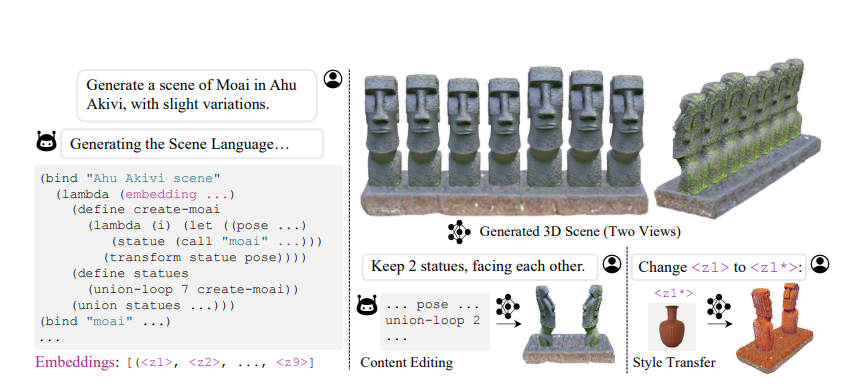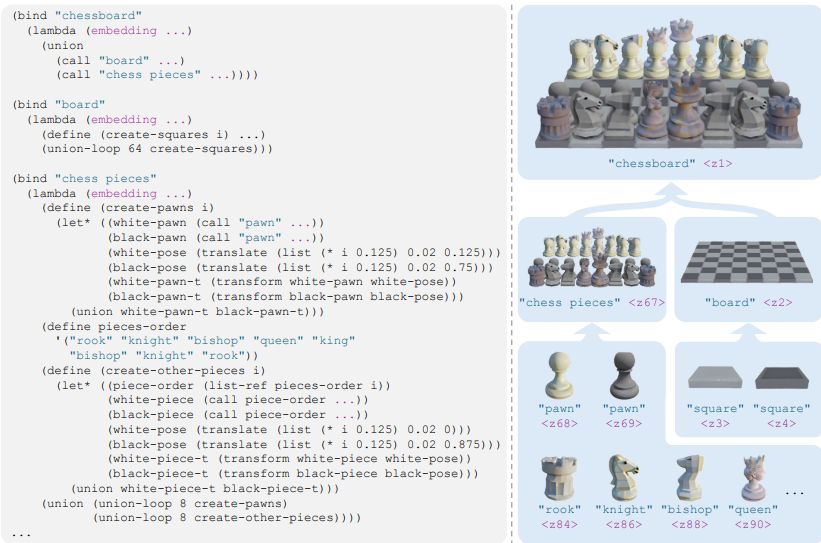Stanford University's Wu Jiajun team has developed a breakthrough technology - "scene language", which can automatically generate lifelike 3D models with just a sentence or a picture. This technology combines three kinds of information: program, text and embedded vector, and transforms natural language description into visual scene, providing designers and game developers with unprecedented convenience. The editor of Downcodes will take you to have an in-depth understanding of this amazing technology, explore its core principles, application prospects and future development directions, and reveal how it turns cool scenes in science fiction movies into reality.
Do you still remember those cool 3D scenes in science fiction movies? Vast universes, fantasy castles, future cities... Now, you can easily create such scenes! The latest **"Scene Language"* launched by Stanford University's Wu Jiajun team * Technology allows you to automatically generate a lifelike 3D model just by describing the scene in one sentence, which is great news for designers and game developers!
What exactly is scene language?
Imagine you are trying to describe the mysterious Ahu Akiwi monolith on Easter Island. You would say: "There are a row of seven Moai statues there, facing the same direction." But if the other person doesn't know what the Moai statues are, you have to explain: "The Moai statues are stone human figures without legs, but Each one looks slightly different.”

This example tells us that to completely describe a scene, at least three types of information are needed:
Structural information: For example, "a row of seven stone statues" can be described by a program similar to a programming language;
Category semantics: For example, "Moai statue" can be summarized in words;
Instance details: For example, the specific shape, color, and texture of each stone statue are difficult to describe in words, but they can be identified through images.
Scene language is the perfect fusion of these three types of information! It contains three core elements:
Program: Use programming language-like syntax to define the hierarchical relationship and spatial layout of objects in the scene, such as the arrangement of Moai statues;
Text: Use natural language to describe the category semantics of each object, such as "Moai";
Embedding vectors: Vectors generated by a neural network are used to capture the visual characteristics of each object, such as the unique appearance of each stone statue.

The most amazing thing is that scene language can be automatically generated through pre-trained language models! You only need to enter a text description or a picture, and the model can automatically infer the program, text and embedding vectors, and then use various renderers to generate high-quality Quality 3D scenes.
What are the advantages of scene language?
Compared with traditional scene graph representation, scene languages are able to generate more complex and realistic scenes, and the scene structure can be precisely controlled and edited. For example, you can modify the properties of an object in the scene, add a new object, or even change the style of the entire scene with one sentence of instructions.
What are the applications of scenario language?
Scene language has wide application prospects in the field of 3D scene generation and editing, such as:
Generate 3D scenes from text: Enter a text description and the corresponding 3D scene will be automatically generated, such as "a castle on the top of a mountain, surrounded by dense forests";
Generate 3D scenes from pictures: input a photo and you can reconstruct the 3D scene in the photo, for example, generate a 3D living room model based on a living room photo;
4D scene generation: 4D scenes that contain time dimension information can be generated, such as simulating the rotation of a wind turbine;
Scene editing: By modifying the scene language's programs, text, or embedded vectors, precise editing of the scene can be performed, such as changing the color, position, or size of objects.
The future development direction of scene language?
Scenario language is still in the early stages of development, and there is still a lot of room for development in the future, such as:
More powerful generation capabilities: can generate more complex and realistic scenes, such as containing more details and richer interactive elements;
More convenient editing method: you can use more natural and intuitive language to edit scenes, such as using voice or gesture control;
Wider application fields: Can be used in virtual reality, augmented reality, game development, film production and other fields.
Project homepage: https://ai.stanford.edu/~yzzhang/projects/scene-language/
Paper address: https://arxiv.org/abs/2410.16770
All in all, "scene language" technology has brought revolutionary changes to the field of 3D scene generation and editing. Its convenience, efficiency and powerful generation capabilities make it have unlimited possibilities in the future. I believe that with the continuous development of technology, "scene language" will play an important role in more fields and create a more vivid and realistic virtual world for us.